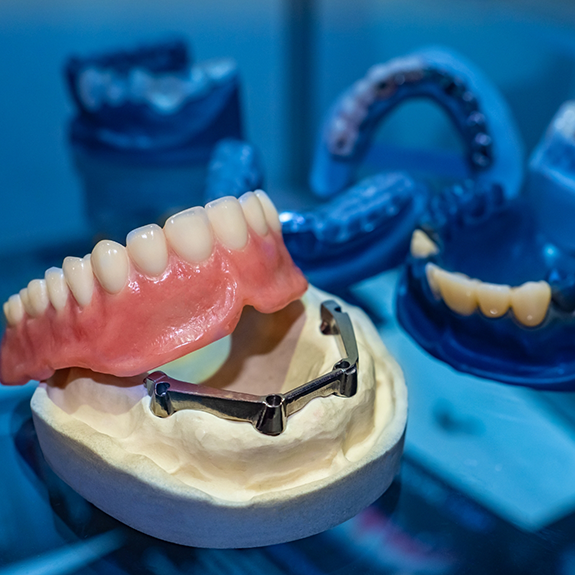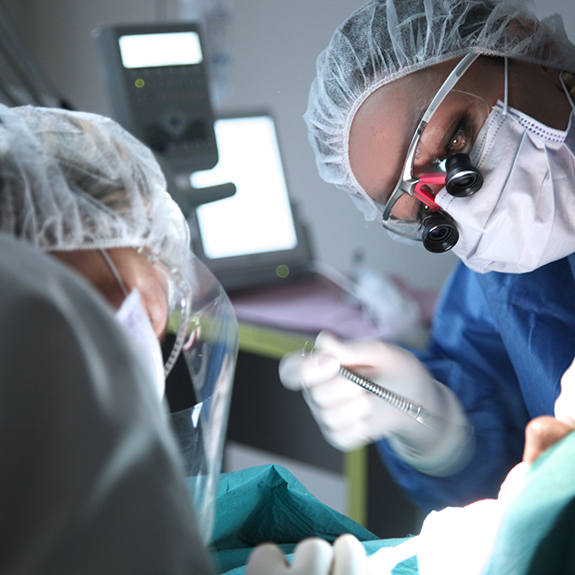Implant Dentures Reynoldsburg
No More Slipping and Sliding Dentures
Dr. Glynn offers a couple of methods of tooth replacement for patients that are edentulous (missing all of their teeth). A secure and convenient option is implant dentures in Reynoldsburg. Dental implants keep your dentures in place for better function and appearance. Dr. Glynn can design either fixed or removable implant dentures for you. Either way, you’ll have a beautiful smile!
Why Choose Glynn Dental of Reynoldsburg for Implant Dentures?
- Give Your Denture Better Stability
- No Need for Denture Adhesive
- Fully Personalized & Natural-Looking
How Do Implant Dentures Work?

As the name suggests, dental implants are used to hold the dentures in place. Four or more implants are surgically embedded toward the front of your upper or lower jaw if you need a full denture. This area of the jaw offers the greatest bone density to ensure a solid foundation for your new teeth. In the case of a partial denture, only one or two implants will likely be necessary.
Am I a Candidate for Implant Dentures?

Implant dentures in Reynoldsburg could be right for you whether you are a current denture wearer or will be getting dentures for the first time. Dr. Glynn will initially conduct a complete oral exam to ensure that your gums and underlying bone structure are healthy. Strong gums and alveolar bone are essential to the long-term success of implant-supported dentures. Digital X-rays will also show if you have sufficient bone density to hold the implants in place. If not, then a bone graft could solve this problem.
The Implant Denture Procedure

Dr. Glynn prepares your individualized treatment plan based on information gathered with X-rays and impressions of your gum ridge.
At the first implant appointment, an incision is made in your gums to expose the bone. A small hole is made in the bone and the implant is secured. The incision is stitched closed, and you are given post-op instructions to help keep the site clean and promote healing.
Once the implant and bone tissue have bonded together, a healing cap is placed on top of the implant so your gums form around it. This prevents gum tissue from getting in the way of your new dentures. Finally, another set of impressions is taken of your gums and the abutments, so your dentures can be handcrafted in the dental lab. Custom adjustments are made in the dental office to ensure a perfect fit.
Benefits of Combining Dentures and Dental Implants

In addition to keeping your new dentures secured, dental implants provide other benefits, too. Most importantly, they help to keep your jaw well-formed and your face looking younger.
When you have a missing tooth, you also have a missing root. A root does more than just keep a tooth in place. That root helps to maintain your healthy jaw. When you use a tooth to bite down, it’s like a signal to your circulatory system to send blood and nutrients to the site. Therefore, when a tooth is missing, circulation to the area falls off, and the bone can begin to deteriorate. Consequently, your jawbone shrinks. But a dental implant acts just like a tooth root, providing the stimulation necessary to keep your jaw strong and healthy.
I Need a Checkup & Cleaning I am Worried About Gum Disease I Have a Cavity or Broken Tooth I am Missing One or More Teeth I Want to Enhance My Smile I Want a Straighter Smile I am Scared of the Dentist I Am in Pain & Need Help I Have Jaw Pain I'm Having Trouble Sleeping View Our Services
